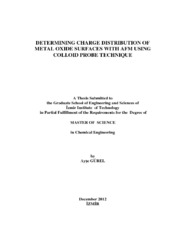Please use this identifier to cite or link to this item:
https://hdl.handle.net/11147/3528Full metadata record
| DC Field | Value | Language |
|---|---|---|
| dc.contributor.advisor | Polat, Mehmet | en |
| dc.contributor.author | Güler, Ayşe | - |
| dc.date.accessioned | 2014-07-22T13:51:44Z | - |
| dc.date.available | 2014-07-22T13:51:44Z | - |
| dc.date.issued | 2012-12 | en |
| dc.identifier.uri | http://hdl.handle.net/11147/3528 | - |
| dc.description | Thesis (Master)--Izmir Institute Of Technology, Chemical Engineering, Izmir, 2012 | en |
| dc.description | Includes bibliographical references (leaves: 86-89) | en |
| dc.description | Text in English; Abstract: Turkish and English | en |
| dc.description | xvi, 103 leaves | en |
| dc.description | Full text release delayed at author's request until 2015.05.12 | en |
| dc.description.abstract | Colloidal systems of micron-sized particles dispersed in a solvent are widely encountered in numerous industries. Homogeneity, dispersibility, rheology and forming characteristics of these systems depend solely on particles-particle interactions which in turn are determined by Van der Waals (vdW) and Electrical Double Layer (EDL) forces. The vdW forces are not affected by system chemistry. However, the EDL forces, which arise from the charging of on solid surfaces in a solvent, vary significantly with solution chemistry. So, manipulation of electrical forces is used widely in industrial applications to manipulate colloidal systems. Colloidal particles in solution carry a distribution of positive, negative and neutral charges depending on solution chemistry. Electrophoretic potential mesurements or colloidal titration methods yield only an average charge for the whole population, not the charge distribution on each particle surface. The streaming potential techniques also provide an average charge on the surface. Currently, there is no accepted technique to determine the charge distribution on solid surfaces. This work aims at using Atomic Force Microscopy (AFM) as a charge probe to achieve exactly this. The work improves on a recent study (Yelken, 2010) which used commercial SiN4 cantilevers to determine the charge distribution on quartz and sapphire surfaces by replacing SiN4 cantilevers with custom-made colloid probes of desired material (quartz in this case) to probe the surface. The current work which improves the flexibility and resolution of the method was tested with two quartz and | en |
| dc.language.iso | en | en_US |
| dc.publisher | Izmir Institute of Technology | en |
| dc.rights | info:eu-repo/semantics/openAccess | en_US |
| dc.subject.lcsh | Surface chemistry | en |
| dc.subject.lcsh | Atomic force microscopy | en |
| dc.subject.lcsh | Surfaces (Technology)--Analysis | en |
| dc.subject.lcsh | Intermolecular forces | en |
| dc.title | Determining charge distribution of metal oxide surfaces with afm using colloid probe technique | en_US |
| dc.type | Master Thesis | en_US |
| dc.institutionauthor | Güler, Ayşe | - |
| dc.department | Thesis (Master)--İzmir Institute of Technology, Chemical Engineering | en_US |
| dc.relation.publicationcategory | Tez | en_US |
| item.languageiso639-1 | en | - |
| item.fulltext | With Fulltext | - |
| item.openairecristype | http://purl.org/coar/resource_type/c_18cf | - |
| item.openairetype | Master Thesis | - |
| item.grantfulltext | open | - |
| item.cerifentitytype | Publications | - |
| Appears in Collections: | Master Degree / Yüksek Lisans Tezleri | |
Files in This Item:
| File | Description | Size | Format | |
|---|---|---|---|---|
| 450174.pdf | MasterThesis | 4.97 MB | Adobe PDF |  View/Open |
CORE Recommender
Page view(s)
1,318
checked on Jul 22, 2024
Download(s)
106
checked on Jul 22, 2024
Google ScholarTM
Check
Items in GCRIS Repository are protected by copyright, with all rights reserved, unless otherwise indicated.